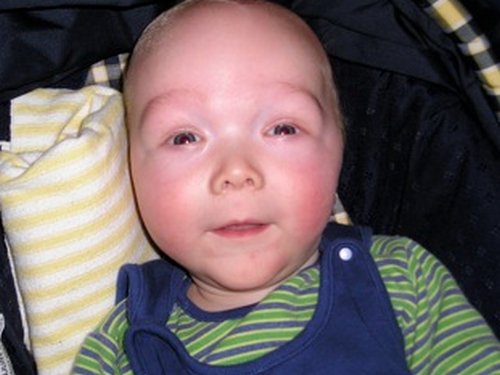Sotos Syndrome
What is Sotos Syndrome?
A Sotos syndrome is a disorder caused by genetic abnormalities. It is characterized by distinct facial appearance, developmental delay, learning difficulty, and overgrowth in childhood. The face of a person with Sotos syndrome is long and narrow.
The forehead is high and cheeks are red. The chin is small and pointed. The distinct facial appearance is prominent in the early childhood. Children with sotos syndrome grow quicker than their peers and their head is large. Other medical terminologies for sotos syndrome are Sotos-Dodge Syndrome and cerebral gigantism. (1)
Sotos syndrome Pictures

Image 1 : An infant with sotos syndrome characterized by pointed chin, big head, wide forehead, and pinkish cheeks
Photo Source : sotossyndrome.org
 Figure 2 : Clinical manifestations of sotos syndrome in adult patient.
Figure 2 : Clinical manifestations of sotos syndrome in adult patient.
Picture Source : sotossyndrome.org
Sotos Syndrome Symptoms
- A person has intellectual disability.
- There is behavioural problem such as ADHD(attention deficit hyperactivity disorder).
- There is an impulsive behaviour like obsessions and tantrums.
- It is common to have a speed and language difficulty such as stuttering and monotone voice. Some patients have problem producing sounds.
- Early motor skills are delayed such as crawling and sitting caused by hypotonia (weak muscle tone).
- Scoliosis (abnormal curvature of the spine)
- Vision-related problems such as blurring of vision and strabismus (cross-eyed or wall-eyed)
- Hearing problem
- Seizures
- Kidney problems
- Heart problems
- Jaundice (yellowish discoloration of the skin) in babies
- Poor feeding in pediatric patients
- Frequent infection of the upper respiratory tract
- Sotos syndrome adults are within the average height and intellect, but coordination problems remain until adulthood. (2, 3)
What causes sotos syndrome?
Sotos syndrome is linked with genetic abnormality. The primary cause of sotos syndrome is NSD1 gene mutation. The NSD1 gene carries the instruction for protein creation, which acts as a histone methyltransferase, a particular type of enzyme responsible in changing histones (structural protein).
The histone attaches to the DNA and is responsible in determining the shape of the chromosomes. Through the process called methylation, a molecule methyl group is added to the histones to form histone methyltransferases, which regulate the activity of a particular type of genes.
It is the NSD1 protein that controls the gene’s activity, especially the ones that have to do with growth and development. Some genetic changes that involve NSD1 gene hinders a portion of the gene to release functional protein. The growth and development of the genes are disrupted if the amount of NSD1 protein is not sufficient, which could lead to Sotos syndrome and other genetic abnormality. (4, 5)
Prevalence rate
This genetic condition affects both males and females equally and can occur in any ethnic group. However, this condition is very rare. The ratio is one in every 14,000 live births.
Sotos Syndrome Diagnosis
There is no definite laboratory procedure that will solely confirm the diagnosis of Sotos syndrome. What medical practitioners do is they check the bone age of the patient, which can be easily examined through an x-ray of the wrist. The doctor will also look for signs of developmental delay, muscle tone, and facial features. (6)
The diagnostic criteria for sotos syndrome include:
- Growth – The child has an abnormal increased in length, height, weight, and head circumference at birth. As the child grows older, the height and weight normalized, but the head remains large.
- Bone age – The bone structure is advance for the age of the patient as seen in the x-ray.
- Appearance – The patient’s head is large, forehead is high, the shape of the face is elongated, and the chin is long. The space in between the eyes is wide and the eyes tend to slant downward.
- Development – There is developmental delay, both in motor and mental skills. Behavioural problem is common as well. (7)
MRI Scan
An MRI scan of the brain is sometimes required to thoroughly check the structure of the brain. The brain of children with sotos syndrome have extra fluid on the surface. The ventricles are enlarged and the size of corpus callosum is significantly reduced. As with the size of the brain, it is within the normal range. A positive diagnosis of sotos syndrome will show the following results of MRI scan:
- The size of corpus callosum is small than the usual
- There is excess fluid between the skull and brain
- The cerebellar vermis is small particularly in lobules six and sseven
- The size of the ventricles is huge, especially in the trigone region (8)
Sotos Syndrome Treatment
Sotos syndrome treatment is directed towards the relief of symptoms. It usually requires a team of specialist to thoroughly manage the symptoms and help people with sotos syndrome live a normal life. physical therapist along with other health care professionals like neurologist, speech therapist, surgeon, and ophthalmologist need to work hand in hand. Together, they are going to come up with a comprehensive treatment management plan.
Children suffering from sotos syndrome are required to have a thorough examination every year. The examination consists of eye check-up, checking for back related problems like scoliosis, evaluation of language and speech, and the likes. It is a must to clinically evaluate the condition of the patient on a continuous basis to check the extent and severity of symptoms.
A significant part of sotos syndrome management is offering emotional and peer support, not only to children with sotos syndrome but also to their immediate family. (9)
There is sotos syndrome support association, which is a non-profit organization that helps bring together patients, medical professionals, and families. The organization also conducts genetic counselling, which is highly beneficial to patients and their families. It provides awareness, information, and support to patients and their immediate family. Some support groups have health care professionals and they function as medical advisors. (10)
What to keep in mind?
About 2% of patients with sotos syndrome may develop benign tumor and malignancy. Hence, it is important to conduct a routine screening. Patients with sotos syndrome are advised to have a regular check-up, at least once a year. As mentioned above, there is no standard course of treatment for sotos syndrome.
The symptoms are not life-threatening, but they should be thoroughly managed for the patients to live a normal life. Patients with sotos syndrome have an average life expectancy.
References:
- https://en.wikipedia.org
- https://rarediseases.org
- sotossyndrome.org
- www.orpha.net
- https://syndromespedia.com
- www.childgrowthfoundation.org
- www.brainfacts.org
- www.medlink.com
- www.sssac.com
- Clinical and Molecular Analyses of Sotos Syndrom by Katrina Louise Tatton Brown
